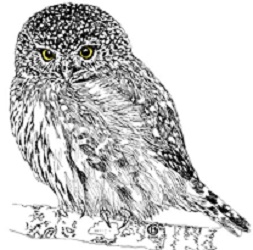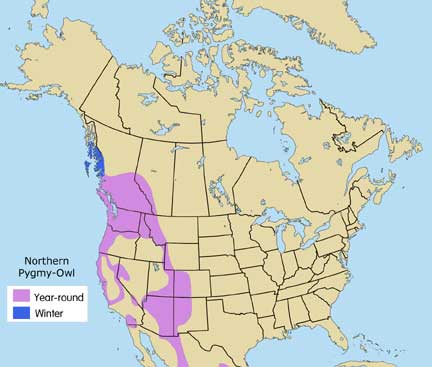
Scientific Name: Glaucidium gnoma
This is a little woodland species, with a small head, stout body, short wings, and a long tail. Females are larger than males. Plumage is brown above, with spotting on the head, neck, and upper parts; the breast, belly and flanks are whitish and streaked dark brown; the brown tail is barred. The face has white and brown bands, with yellow eyes and bill, and a white chin; the throat is brown with white spots. Large, black, false eye spots on the back of the head may help the little owl evade predators, by giving the impression that this bird is bigger than it really is. Plumage is similar between the sexes, although males may be slightly grayer, and females slightly redder in coloring. This owl will sometimes adopt a concealment posture, erecting little feather tufts on the head, compressing the body feathers, and drawing one wing across the front of the body to blend into a wooded background. Flight is mostly short, perch to perch movements, in a low, undulating pattern just above the ground.
Male/Female
Length: 6.75″ ave.
Wingspan: 12″ ave.
Weight: 2.5 oz. ave.
This little owl has adapted to a variety of forest habitats with nearby clearings, from deciduous bottomlands, to high elevation coniferous forests, to wooded canyons in arid regions. Any forest environment where cavities excavated by woodpeckers make nest sites available.
The characteristic call of this little owl is several toots, one or two seconds apart, followed or preceded by a higher-pitched, rapid trilling note.
Northern Pygmy Owls rely on woodpeckers to create cavities suitable for nest building, although natural cavities will also be used if available. These owls use bark strips, feathers, mosses and lichen to line their nests. The few nests found have been surprisingly deep – as much as 36″.
Sometimes collide with vehicles, or fly into windows. Forest habitat for this species is lost through removal of nesting snags with woodpecker holes.

Ranges from Alaska and western Canada, down into mountainous areas of the western US and Mexico, to Central America. Resident year-round throughout its range, it moves to lower elevations in winter.
Special Thanks for range maps:
Dan Gleason
BGleason Design & Illustration
Commercial & Scientific Illustration, Graphic Design
CraneDance Communications
Book Production/Design

